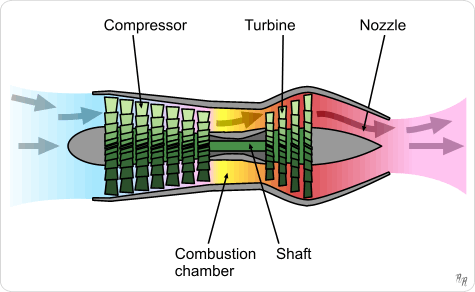The first jet engine, the turbojet, made by British engineer Frank Whittle, worked something like this. The thrust came from the air that was pushed into the front of the engine. Then, the air travelled into the compressor where it was squeezed, mixed with fuel, and ignited. This causes the air, now very hot, to shoot out of the back of the engine, causing thrust.(The compressor was turned by a turbine that used exhaust gases to power itself.) But, these engines had a problem. They were not very fuel efficient and were very loud.
 Next, came the turbofan engine, the engines that we use today. These engines worked similar to the turbojet engines. A fan, powered by the turbine, directed some air to move around the compressor instead of through it. Even though this air is not moving as fast as the exhaust gases, the sheer volume of it gives it more thrust than the turbojet. This made the engine more fuel efficient and quieter. Some of the latest and biggest turbofans engine fans are so big that they have a bypass ratio of 9:1. To explain this, we have to get into little math. Let's say that we have ten parts of air. The 9:1 ratio means that only 1 part of the air is going inside the compressor while the other 9 parts are going around. This is much more efficient and provides a lot more thrust. These fans are getting bigger and bigger, but there is a limit to which they can grow. As these fans get bigger, they also get faster and some fans are getting close to the speed of sound. If these fans reach the speed of sound, they will produce shock waves that cause dangerous vibrations. To slow down the fans but still keep the turbine running at an optimal speed, we need gearboxes. This is where the Purepower by Pratt and Whitney that is a geared turbofan engine comes in.
Next, came the turbofan engine, the engines that we use today. These engines worked similar to the turbojet engines. A fan, powered by the turbine, directed some air to move around the compressor instead of through it. Even though this air is not moving as fast as the exhaust gases, the sheer volume of it gives it more thrust than the turbojet. This made the engine more fuel efficient and quieter. Some of the latest and biggest turbofans engine fans are so big that they have a bypass ratio of 9:1. To explain this, we have to get into little math. Let's say that we have ten parts of air. The 9:1 ratio means that only 1 part of the air is going inside the compressor while the other 9 parts are going around. This is much more efficient and provides a lot more thrust. These fans are getting bigger and bigger, but there is a limit to which they can grow. As these fans get bigger, they also get faster and some fans are getting close to the speed of sound. If these fans reach the speed of sound, they will produce shock waves that cause dangerous vibrations. To slow down the fans but still keep the turbine running at an optimal speed, we need gearboxes. This is where the Purepower by Pratt and Whitney that is a geared turbofan engine comes in. |
| The fan will have a gearbox behind it and the engine will be bigger |
It is too early to say whether the Purepower will be a success or not, but one thing is for sure. it will revolutionize the process of engine manufacturing.

No comments:
Post a Comment